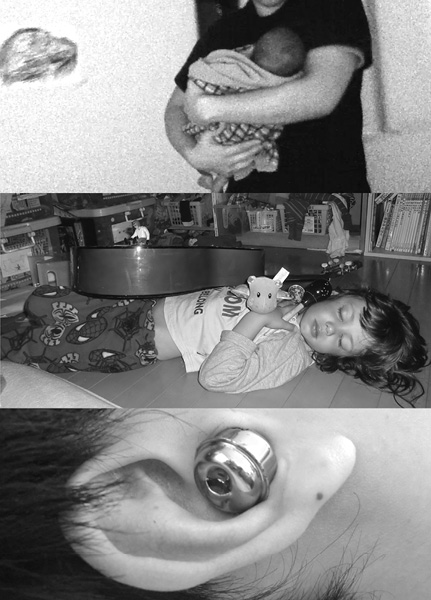
SOUND ASLEEP
first performed on
January 1, 2011
Corpo Plumhill, Tokyo, Japan
performed once in 2011
NO COLLECTIVE
You Nakai, Gen Gluzman, Aevi Nakai Gluzman
Tokyo, Japan / New York, NY
978170267y978170267o978170267u978170267@978170267n978170267o978170267c978170267o978170267l978170267l978170267e978170267c978170267t978170267i978170267v978170267e978170267.978170267c978170267o978170267m
nocollective.com
SOUND ASLEEP
NO COLLECTIVE
Second piece in a series of performative endeavors to articulate the deep and paradoxical relationship between sound and sleep (the first of which was “Lullaby,” composed/performed in 2010). The three stages followed the described order during the premiere but may be arranged differently. The piece is written for three performers of different ages, though not all three are required for each stage. One performer should be a newborn infant under a year old, the second should be a child under seven, and the third should be an adult over 16. The audience member who falls asleep during any of the stages is considered, from that moment, as a sleeping performer. If any sleeping performer is woken up by any sound emitted during the performance, the same stage starts again from the beginning. One entire performance with the three stages may take any length of time-the shortest would be an overnight performance. The premiere took approximately eight months and was performed by You Nakai, Gen Gluzman, and Aevi Nakai Gluzman.
Stage One: This stage can only start when the infant performer is awake. One performer uses any sound (e.g., prolonged high-pitched vocalization, as used at the premiere, etc) to make the infant performer fall asleep. The infant may or may not respond to this by making sound him/herself. The stage ends when the infant performer is successfully lulled into sleep. If more than two performers participate, the third may assist the first, or the two may take turns.
Stage Two: This stage can only start when the child performer is asleep. The performer who is awake puts sound-producing objects (e.g., guitars, shakers, tambourines, etc) upon the body of the sleeping performer. This should be done with maximum care so as not to wake him/her. As many sound objects as possible should be used. When all sound objects are placed, or it is decided that no more are possible, the performer who is awake becomes a part of the audience. This stage ends when all the objects fall off the sleeping performer. If more than two performers participate, the third may assist the first, or the two may take turns.
Stage Three: This stage can only start when the adult performer is asleep. The performer who is awake puts a jingle-bell inside the ear of the sleeping performer. This should be done with maximum care so as not to wake him/her. After the task is accomplished, the performer who is awake becomes a part of the audience. This stage ends when the sleeping performer wakes up on his/her own and takes the bells out of his/her ears. If more than two performers participate, everyone but the sleeping performer cooperates.